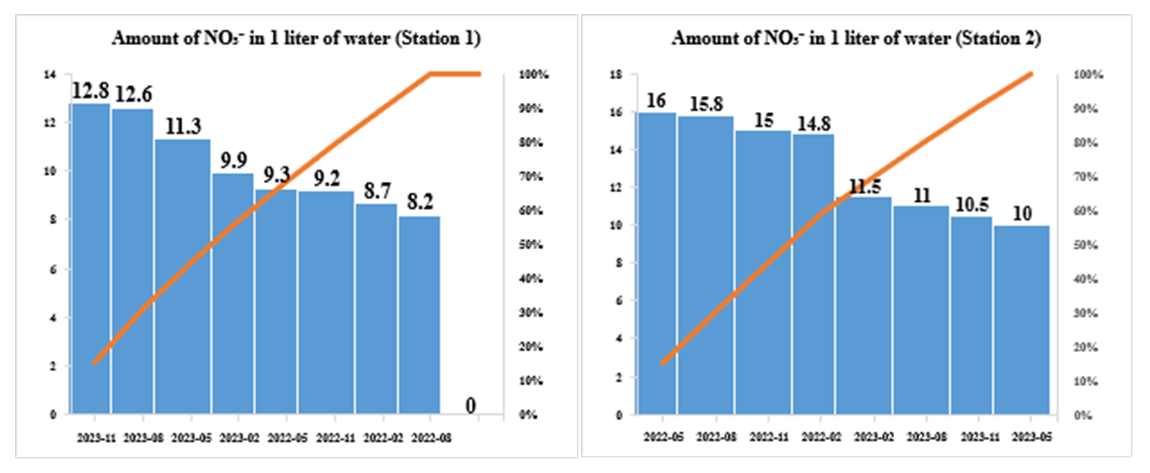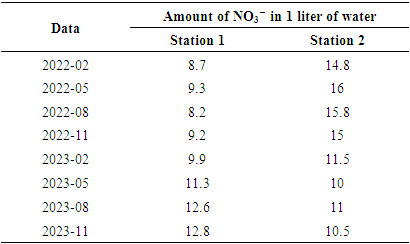-
Paper Information
- Paper Submission
-
Journal Information
- About This Journal
- Editorial Board
- Current Issue
- Archive
- Author Guidelines
- Contact Us
International Journal of Virology and Molecular Biology
p-ISSN: 2163-2219 e-ISSN: 2163-2227
2024; 13(6): 102-104
doi:10.5923/j.ijvmb.20241306.06
Received: Nov. 15, 2024; Accepted: Dec. 22, 2024; Published: Dec. 30, 2024

Assessment of Groundwater Quality by Nitrate Anions
Rajabova Nilufar1, Sherimbetov Vafabay2
1PhD Student, National University of Uzbekistan named after Mirzo Ulugbek, Uzbekistan
2Doctor of Philosophy (PhD) in Biological Sciences, Head of the Department of Ecology, National University of Uzbekistan named after Mirza Ulugbek, Uzbekistan
Correspondence to: Rajabova Nilufar, PhD Student, National University of Uzbekistan named after Mirzo Ulugbek, Uzbekistan.
| Email: |  |
Copyright © 2024 The Author(s). Published by Scientific & Academic Publishing.
This work is licensed under the Creative Commons Attribution International License (CC BY).
http://creativecommons.org/licenses/by/4.0/

This study is aimed at assessing the water quality based on nitrate concentrations in groundwater in Amudarya district and Kungirot district of the Republic of Karakalpakstan, Uzbekistan. The main objective is to analyze the quality of drinking water sources based on nitrate content. The research object is nitrate anions. The methodology includes collecting groundwater samples at a depth of 10-20 meters and analyzing nitrate concentrations following the GOST 33045-2014 standard. The results showed nitrate concentrations of 9.3 mg/l at station 1 and 16 mg/l at station 2 in 2022. In 2023, nitrate concentrations decreased at both stations. It is known that high nitrate concentrations in drinking water can lead to methemoglobinemia, cancer, and cardiovascular diseases, particularly in infants and elderly individuals. The novelty of this work includes recommendations aimed at introducing a permanent environmental monitoring system and improving drinking water quality, which is crucial for protecting public health.
Keywords: Nitrate anion, Groundwater, Methemoglobinemia, GOST 33045-2014, Agricultural activity, Health risks, Environmental technologies
Cite this paper: Rajabova Nilufar, Sherimbetov Vafabay, Assessment of Groundwater Quality by Nitrate Anions, International Journal of Virology and Molecular Biology, Vol. 13 No. 6, 2024, pp. 102-104. doi: 10.5923/j.ijvmb.20241306.06.
Article Outline
1. Introduction
- Maintaining and protecting the quality of water sources in the biosphere is important for the stability of every living organism in the ecosystem. Agricultural activity, especially the flow of nitrogen compounds, the increase of nitrate and nitrite concentrations in surface and underground water has been proven by scientists from all over the world. An increase in nitrates in drinking water can cause various problems in water supply systems, especially in relation to human health [1-3]. Therefore, one of the most important issues is the monitoring of the amount of nitrates in the underground water formed in agricultural lands according to constant and accurate methods1. The increase in nitrate concentrations in drinking water is primarily attributed to agricultural runoff and wastewater pollution.According to the guidelines of the World Health Organization (WHO), the maximum permissible concentration for nitrates should not exceed 50 mg/l. This limit is established to prevent methemoglobinemia, a condition that affects infants2. APPROVED in Uzbekistan on January 10, 2005, No. 0182-05, June 1, 2006, No. 0211-06 and by the order of the Standards Institute of Uzbekistan No. 9/MSt of April 9, 2024 According to regulations such as «UzMSt 133:2024», this range is defined as 45 mg/dm³. The limits defined in these documents serve as the most important tool in maintaining the health of the population based on the tolerance limit [4-6].
2. Materials and Methodology
2.1. Research Object
- The research focuses on the nitrate anion concentrations in groundwater at depths of 10-20 meters in two districts of Karakalpakstan, Uzbekistan. The stations are located in Almazor MFY (Station 1) in Amudarya district and Kungirot (Station 2) district. Groundwater samples were collected and analyzed following the GOST 33045-2014 standard to determine nitrate levels.
2.2. Nitrate Determination Procedure
- Nitrate concentrations in the water samples were measured using the colorimetric method with sodium salicylate and sodium hydroxide, as described in GOST 33045-2014. Standard reagents were prepared, and the procedure was followed to detect nitrate levels using a photometer.
3. Results and Discussion
3.1. Analysis Results
- Table 1 presents the results of laboratory analysis according to Uzbekistan's National Standards. The samples were collected from stations 1 and 2 in February, May, August, and November of 2022 and 2023.
|
3.2. Growth Trends
- If we depict the variable values in the above table 1 through diagram 1, the growth rate in 2022 station 1 showed lower indicators compared to station 2. However, in 2023, the amount of nitrates at station 2 increased significantly. At station 1, the amount of nitrates changed depending on the periods, and the highest value was 9.3 mg/l in 2022 and 12.8 mg/l in 2023. These values were 16.8-11.5 mg/l at station 2.
 | Diagram 1. Growth trends of NO₃⁻ anions during 2022-2023 |
3.3. Toxicological Effect
- Drinking water with high nitrate or nitrite ions causes Methemoglobinemia (MetHb). This disease is more common in babies. The reason is their low level of resistance to environmental factors. First of all, in the mechanism of its appearance, NO3⁻ ions enter the body together with water, and intestinal microorganisms (Enterobacteriaceae, Bacteroides, Lactobacillus) convert NO3⁻ ions into NO2⁻ ions [1,4,6-8]. We can describe this process by the following reaction equation.
 NO2⁻ ions enter the blood and oxidized Fe²⁺ to methemoglobin - Fe³⁺.Fe ²⁺ + NO2⁻ + 2H+ →Fe⁺³ (MetHb) + NO + H2OIf we analyze the mechanism of action on the human body in a broader way, drinking water with high nitrate concentrations can lead to methemoglobinemia (MetHb), a condition that is particularly dangerous for infants. Nitrate ions (NO₃⁻) are reduced to nitrite ions (NO₂⁻) by intestinal bacteria, which then oxidize iron in hemoglobin, forming methemoglobin (Fe³⁺). This reduces the ability of blood to carry oxygen, leading to hypoxia, also known as "blue baby syndrome." Prolonged exposure to elevated nitrate levels can also cause cancer and cardiovascular disorders [3,5,8].The effects of nitrate concentrations in groundwater on human health are classified as follows:10 mg/l: Safe for consumption.10-20 mg/l: Low risk, but MetHb may occur.20-50 mg/l: Dangerous, especially for young children.> 50 mg/l: Highly dangerous and unsuitable for consumption.
NO2⁻ ions enter the blood and oxidized Fe²⁺ to methemoglobin - Fe³⁺.Fe ²⁺ + NO2⁻ + 2H+ →Fe⁺³ (MetHb) + NO + H2OIf we analyze the mechanism of action on the human body in a broader way, drinking water with high nitrate concentrations can lead to methemoglobinemia (MetHb), a condition that is particularly dangerous for infants. Nitrate ions (NO₃⁻) are reduced to nitrite ions (NO₂⁻) by intestinal bacteria, which then oxidize iron in hemoglobin, forming methemoglobin (Fe³⁺). This reduces the ability of blood to carry oxygen, leading to hypoxia, also known as "blue baby syndrome." Prolonged exposure to elevated nitrate levels can also cause cancer and cardiovascular disorders [3,5,8].The effects of nitrate concentrations in groundwater on human health are classified as follows:10 mg/l: Safe for consumption.10-20 mg/l: Low risk, but MetHb may occur.20-50 mg/l: Dangerous, especially for young children.> 50 mg/l: Highly dangerous and unsuitable for consumption.4. Summary
- In conclusion, the nitrate content at Station 1 ranges from 8.7 mg/l to 12.8 mg/l, while at Station 2 these amounts range from 10.5 mg/l to 16 mg/l. This means that nitrates in the water are moderately toxic.
5. Recommendations
- 1. A permanent and accurate groundwater monitoring system should be established to regularly assess nitrate concentrations and address environmental issues promptly.2. Agricultural practices should adopt environmentally sustainable technologies, improve wastewater treatment, and reduce the impact of nitrogen compounds on the ecosystem.3. Public awareness campaigns should educate the population on the health risks associated with high nitrate concentrations and promote measures to improve drinking water quality.4. The regulatory framework in Uzbekistan should be updated to align with modern standards and address contemporary environmental challenges. Specifically, the maximum permissible nitrate concentrations should be reviewed.
Notes
- 1. Guidelines for Canadian Drinking Water Quality: Guideline Technical Document - Nitrate and Nitrite: https://www.canada.ca/en/health-canada/services/publications/healthy-living/guidelines-canadian-drinking-water-quality-guideline-technical-document-nitrate-nitrite/page-2-guidelines-canadian-drinking-water-quality-guideline-technical-document-nitrate-nitrite.html.2. World Health Organization. (2022). Guidelines for drinking-water quality: incorporating the first and second addenda. World Health Organization.
 Abstract
Abstract Reference
Reference Full-Text PDF
Full-Text PDF Full-text HTML
Full-text HTML